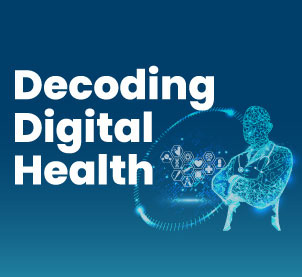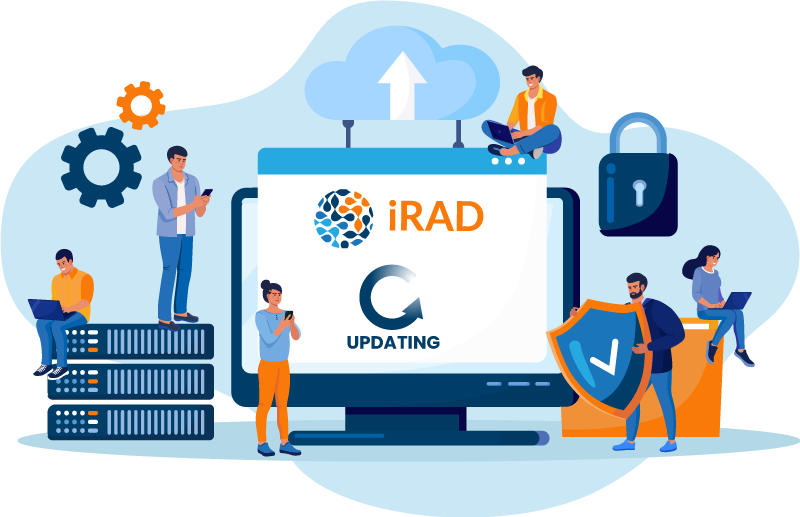07 February 2023

iRAD delivers instant access to patient information for better clinical outcomes with secure, simplified workflows for medical practices, care teams and patients.
The solution
iRAD captures patient information entered into clinical software and exchanges it seamlessly across the healthcare continuum, including data entered in primary care, specialists, tertiary and within My Heath Record.
A single, clear view of a patient’s key clinical information is recorded in real-time, from trusted health providers, for better patient care.
The solution is iRAD
Patient opt-in model
A simple one-off sign-up at each care location automatically starts building a longitudinal record of the patient’s history.
Automated data capture
iRAD automatically completes all upload actions on consented patient records.
Real-time updates
iRAD is fast, accurate and easy to use, ensuring clinicians can spend more time focused on patient care.
Healthcare delivery
iRAD supports transfer of care by providing comprehensive, meaningful, trusted data from the patient’s care team.
Organised by type
Health information from different systems is readily available and easy to interpret. iRAD sorts and collates information for ease of use.
Patient empowerment
iRAD remembers consented patient’s important clinical information from each care location.
The problem
As our diverse population ages and healthcare becomes more complex, the importance of interoperability and data sharing to support effective delivery of healthcare is more critical than ever. Health data has always been challenging to access and share securely. The nature of health data creates a paradox: it is difficult to share because it is sensitive and requires a high level of privacy and security, yet the inability to access it when needed has the potential to cause significant harm.
A lack of interoperability can result in an incomplete understanding of an individual’s health needs. Further challenges include language and other communication barriers, cognitive impairment, those without a regular GP and those living in rural/remote areas. This can lead to poorer outcomes and higher costs.
Challenges and opportunities in digital health
Access
Balancing high-level security controls with ease-of-use for clinical teams.
Interoperability
Ensuring seamless and accurate transfer of information with a shared meaning between healthcare systems.
Data literacy
Understanding personal health data for responsible use, access, sharing and ownership.
Security and privacy
Securely protecting sensitive health information from both unintentional and malicious disclosure.
Information overwhelm
To date, digital health solutions have kept adding more programs and access requirements to resolve gaps and security needs, resulting in increasingly complicated processes for clinicians to consume and synthesise large volumes of data during patient consultations.
iRAD benefits
We are proving interoperability works in Australia and benefits patients, care teams, and clinical administration.
- iRAD solves the interoperability challenge
- Easily share clinical data
- Support clinical decision-making
- Patient consent
- Patient is empowered to choose
- Improve patient outcomes
- Reducing patient re-admissions
- iRAD enhances context of My Health Record
iRAD has worked out how to get disparate Australian health systems talking to each other, securely, and in real-time.
 Benefits for clinicians
Benefits for clinicians
Data sharing
- A care provider can see a comprehensive list of all current medications and recent care provided
- iRAD data is displayed sorted into groups for ease of clinician use
- Information from multiple locations contribute to the patient’s longitudinal record
- Comprehensive records available at-a-glance
- Reports, referrals, results, care plans available 24/7
Reduction in administration
- Notifications alert clinicians to data changes in the past 30 days
- Reduced admin time collecting and collating clinical information
- Improved access to hospital data
Ease of use
- Consent must be collected and recorded from the patient for patient information to start displaying in iRAD
- iRAD automatically updates the patient’s record at the end of each consultation
Support
- 24/7 monitoring of application, database, network and security
- Frequency of database backups
- Application and upgrade management
- Infrastructure management.
 Benefits for hospitals
Benefits for hospitals
Data sharing
- Improved access to quality information from trusted care providers
- Improved access to quality information from trusted care providers
- iRAD delivers powerfully grouped and coded data to support clinical decision-making
Reduction in over testing
- Hospital teams can view latest pathology and imaging results in iRAD
- Patient care provision can be directed by the most recent information
- iRAD reduces additional testing and hastens care delivery
Ease of use
- Ease of access to iRAD data through eHealth NSW’s HealtheNnet
- Consent must be recorded in hospital systems to enable access to iRAD information
Support
- 24/7 monitoring of application, database, network and security
- Frequency of database backups
- Application and upgrade management
- Infrastructure management
“iRAD is an additional planned resilience measure for regional health systems. The ready availability of consented clinical information supports emergency response initiatives to natural disasters and pandemics.”
iRAD technical features list
- 24/7 infrastructure and hosting services
- 24/7 application monitoring
- 24/7 database monitoring, maintenance, and backups
- 24/7 network and security monitoring
- Application and upgrade management
- Infrastructure management
- My Health Record integration
- Australian-based Azure servers
- HL7 FHIR, openEHR and CDA
- Call and store function
- Call and display function
- NSW hospital medical records
- Clinical software integrations
Target patients
Patients with complex conditions and multiple co-morbidities utilise services from many providers to manage their care. iRAD supports coordinated patient care by enabling access to the latest information and providing longitudinal patient records to the care team.

Chronic
Chronic disease
Complex co-morbidities
Multiple treatment locations
 High care needs
High care needs
Residential care facility
Mobility issues
Cognitive issues

Shared care
COVID-19 patients referred to other care locations
Children who utilise multiple primary care settings
Antenatal shared care
Patients attending after hours clinics
Integrated care initiatives

Communication
Poor health literacy
Non-verbal/communication barriers
English as a second language
Patient consent is at the heart of iRAD
iRAD is patient-centric. Its opt-in model empowers the patient to choose their care partners by giving consent to practitioners they trust with their health data. It is a simple one-off sign up at each care location.
Patient consent can be verbal or written consent. To assist patients to understand, consent templates and supporting documents are available in five languages:
- Arabic
- Assyrian
- Simplified Chinese
- English
- Vietnamese
Withdrawal of consent
iRAD’s opt-in model empowers the patient to consent at each location.
If a patient wishes to withdraw iRAD consent, the recording of denied consent at the care location immediately disables access to information from this care location.
The power of care location consent
- Every patient is empowered to choose the practices they provide iRAD consent to
- Locations where a patient has granted consent can view information from every care location where the patient has previously granted consent
- Care locations contribute information to the shared patient iRAD record
- Patient consent is easy to record in iRAD. There is no ongoing effort to trigger the sharing of clinical information
- iRAD instantly facilitates the sharing of identified patient information between iRAD care locations where the patient has consented

Patient identity and matching
Patient clinical information from multiple care locations is collated into a single view.
When a new record is consented, iRAD checks if the patient has consented at any other iRAD care locations. If the patient has consented at multiple care locations, collated data is displayed. If a patient withdraws consent for one care location, information from this location will no longer display at any other consented care provider location.
The success of collated longitudinal records from multiple care locations is based on strong patient identity management.
IRAD’s identity management tool uses a world-class Enterprise Master Patient Index (EMPI). Key patient demographic data elements for consented patients are analysed to create patient clusters using probabilistic algorithms.
Demographic information includes:
- Patient name
- DOB
- Address
- Individual Healthcare Identifier (IHI)
- Medicare number and
- Gender
Minimum data set
iRAD shares a minimum data set using semantic interoperability. After patient consent is recorded, data from the patient record begins contributing to the longitudinal iRAD record. This information includes an initial transfer of care information. Future record updates are automatically transferred to iRAD when the consult is saved.
iRAD shared Information
- Patient demographics
- Provider details
- Encounter dates, providers, and reason
- Medications
- Allergies
- Conditions (current & past)
- Immunisations
- Care plans, referral letters, specialist reports
- Documents
- Pathology results
- Imaging results
- Vital signs, observations, measurements
Technical overview
iRAD is hosted in Australian-based Azure servers and infrastructure. Azure has the deepest and most comprehensive compliance with global internet security and privacy laws. This made Azure the obvious choice for supporting the delivery of iRAD in geographically dispersed locations.
Increases agility
The infrastructure selected and implemented for iRAD enables agile responses to our changing environment.
Adaptive technology
iRAD supports both ‘call and display’ and ‘call and store’ models for data sharing and future federation of data nodes.
Real-time access
Our service team provide 24/7 monitoring ensuring real-time access is constantly available to iRAD clinical information.
Integration support
iRAD’s integration engine supports a large range of protocols and formats including HL7 FHIR, openEHR and CDA.
Data security
iRAD boasts military-grade encryption and a very high level of resilience to threats.
- iRAD complies with all Federal and State data security and privacy legislation.
- iRAD solution is ISO 27001 certified
- All data is stored on Australian-based servers
Access is restricted
Network Security Groups control inbound and outbound ports and network traffic.
Data at rest
Microsoft Storage Service Encryption (SSE) is used to encrypt all data written to the iRAD data centre.
Data in transit
All data is protected to and from iRAD and internally using Transport Layer Security 1.2 Protocol with 2,048-bit RSA/SHA256 encryption keys.
Cloud storage
All components and data are stored in Australian-based Microsoft Azure data centres with locally redundant storage.
Supporting assets
A suite of implementation guides, promotional material and patient consent templates support users looking to make the most of iRAD. Patient collateral is available in five languages: Arabic, Assyrian, Chinese, English and Vietnamese.
Installation & implementation assets
- implementation handbooks
- user guides
- Step-by-step videos on YouTube
- support desk
Promotion & consent assets
- posters
- brochures
- consent kits
- website
Be part of the digital future in healthcare interoperability
By partnering with more primary health networks and other state-based health services we can grow the capacity, reach and usefulness of iRAD.
Since 2016 we have heavily invested in the design and security of iRAD as the interoperable IT ecosystem to deliver better healthcare, for less cost, and in real-time, providing the answer to Australia’s interoperability needs.
iRAD has evolved from a question, to a vision, to an established solution.
By 2019, the iRAD solution was fit-for-purpose and being piloted at four general practice sites in South Western Sydney.
By 2021, iRAD was established at more than 70 care locations with remote installation and site access enabled.
By mid-2023, the new iRAD version will be implemented and our HealthOne project with eHealth NSW will be completed, providing a view of hospital data to GPs, along with a view of primary care data for hospital clinicians.
By the end of 2024, our aim is to have iRAD operating in more than 300 licensed locations with multiple PHN partners in NSW.
The sooner iRAD is implemented, the sooner:
- Longitudinal records will initiate
- Healthcare providers can actively collaborate on a broader scale
- Patient experience improves
- Transfer of care becomes easier
- Preventative measures in healthcare become a reality
Future potential
With more partnerships in place, we envisage iRAD’s potential to be even greater. This includes the possibility of aged care software integration, Ambulance NSW integration, and additional primary care and specialist software integrations as early as this year.
We also see potential for national coverage among PHNs and the possibility of more than 1,000 licensed locations by the end of 2024.
Request an iRAD demo
View available iRAD resources
Introduction to iRAD (YouTube)
ADHA: Interoperability: better connections for better care.





 Benefits for clinicians
Benefits for clinicians Benefits for hospitals
Benefits for hospitals





